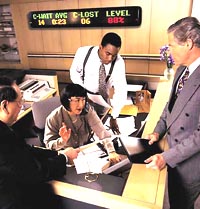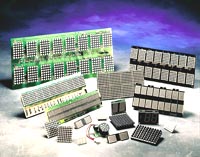|
If you are looking for an LED sign or LED sign information, you are
in the right place.
You'll find a wealth of useful information here, but the next few paragraphs contain the most important information on this site. If you read nothing else, please read this...
There is MUCH more to an LED sign than meets the eye. Looking at an LED sign, you see only the "tip of the iceberg."
 Anyone can make an LED sign, and many companies do. The parts are readily
available and inexpensive, the technology is easy to understand, and
anyone with a soldering iron can assemble an LED array.
Anyone can make an LED sign, and many companies do. The parts are readily
available and inexpensive, the technology is easy to understand, and
anyone with a soldering iron can assemble an LED array.
Don't be seduced by low price or glitzy appearance. Much more important than outward appearance or low price are reliability, the internal firmware programming, the physical engineering of the product, product support, documentation, widespread product acceptance, broad application use, and product and manufacturer longevity.
The most important features of a sign are not visible, and typically,
the information you need to know about the important criteria is difficult
or impossible to find. Yet features that you don't find out about now,
or that seem unimportant now, can become tremendously important and
troublesome later.
As software developers, we have spent ten years researching, evaluating and programming a wide variety of signs to arrive at the recommendations we make and the signs that we use with our programs and offer to our customers.
The following questions should be answered before you purchase an LED display:
- How comprehensive is the internal firmware that runs the display?
- Does the firmware operate exactly the way the manufacturer says it does?
- Is the firmware designed to conveniently do what you need it to do, both now and in the future?
- Is comprehensive documentation available describing the firmware, so that your software can be customized, or special applications can be written if necessary?
- Does the firmware support real-time updating of variables without blinking the sign and without resetting the message file run sequence?
- Who wrote the internal firmware? Can they communicate in English? Are they located in the United States?
- Who supports the firmware? How accessible are they?
- Does the firmware behave consistently over the entire range of signs offered by the sign manufacturer?
- Do you need different firmware for different sign applications from the same manufacturer?
- Is the firmware ever updated?
- Will updated firmware for your unit operate on your unit?
- Where is the sign manufactured?
- Does the manufacturing process utilize state-of-the-art LED brightness and color matching so that your sign doesn't have a patchwork quilt appearance when all the LED's are turned on in each color?
- Where are repairs performed? Are spare parts readily available at a reasonable price?
- How easy is it to reset the sign if it locks up? Do you have to open up the sign, or remove chips from their sockets, or can you easily reset the sign or clear its memory with the programming keyboard or with your computer?
- Are the signs individually addressable in a network of several signs?
- Can multiple signs be assigned the same address without impacting the operation of the sign network?
- How easy is it to change the address of a sign? Do you have to open up the sign? Do you have to change jumpers inside the sign enclosure? Can the address be changed easily with the programming keyboard or with your computer?
- Does the sign come with a built-in computer interface?
- If yes, how cumbersome is it to use?
- How expensive and versatile are the computer attachment features that are not included with the sign?
- Can you easily upgrade the memory of your sign?
- Does each sign have a built-in audible alert, or is this an extra charge item that must be attached externally to the sign?
- Does the manufacturer have a flat rate repair policy?
- Can all the different sign models from the manufacturer be networked together?
- Does the manufacturer offer different models, required by different applications -- multiple line directory for a lobby, outdoor brightness LED's for window applications, large characters for use in a large facility, small characters for use on a desk or in a cubicle, NEMA enclosures for harsh environments, etc. -- that all use the same firmware, so all can be controlled by the same software?
- What application software is available -- local messaging, remote messaging, messaging by multiple networked users, messaging integrated and co-resident with real-time data, custom tools for custom interfaces with real-time input and output equipment, integration tools for Active X applications, customized industry applications (manufacturing, call centers, theaters, etc.)?
- What application hardware is available or supported -- specialized input devices, such as discrete input devices that automatically invoke a variety of messages, TCP/IP interfaces, POCSAG wireless devices, etc.?
- How long has the manufacturer been in business?
- How long have they been making the sign you like?
- Do they make it, or do they just put their name on somebody else's sign?
- How widely accepted are their signs? How many companies use them, and how many integrators incorporate the signs into their own products?
- Is local support (hardware, software, installation, replacement) available from an authorized distributor?
- When a sign breaks, how long does it take to get the sign repaired?
- Is a loaner available, if necessary?
- Can you return the sign for a different model later?
- Is a knowledge base available for the sign via Internet or otherwise?
- How much documentation is available on software, networking, integration, protocol, and customer applications?
 These questions highlight just a few of the issues that don't become
apparent until after you have invested in a sign. Ask these tough questions
before you buy a sign, or buy your sign from someone who understands
your needs, both now and in the future. Buy your sign from a company
that is willing to upgrade your sign later, if necessary, giving you
full credit for your initial investment.
These questions highlight just a few of the issues that don't become
apparent until after you have invested in a sign. Ask these tough questions
before you buy a sign, or buy your sign from someone who understands
your needs, both now and in the future. Buy your sign from a company
that is willing to upgrade your sign later, if necessary, giving you
full credit for your initial investment.
If you choose one of the signs recommended on our website, you can be confident that it meets the stringent criteria above. You'll be getting the best sign you can buy at any price.
Over one hundred years ago, John Ruskin (1819-1900) wrote concerning "quality and price":
"It's unwise to pay too much, but it's worse to pay too little. When you pay too much, you lose a little money. That is all. When you pay too little, you sometimes lose everything, because the thing you bought was incapable of doing the thing it was bought to do. There is hardly anything in the world that some men cannot make a little worse and sell a little cheaper. The common law of business balance prohibits paying a little and getting a lot. It can't be done. If you deal with the lowest bidder, it's well to add something for the risk you take. And if you do that, you will have enough to pay for something better."
For a more detailed discussion of the evaluation criteria above, please give us a call.
Thank you for visiting Alpha-American Programmable Signs. We hope you will give us the opportunity to work with you. If you have any questions or comments, please call us toll-free or use the feedback form.
--Michael Sisk and the staff of Alpha-American
|
 |
|

